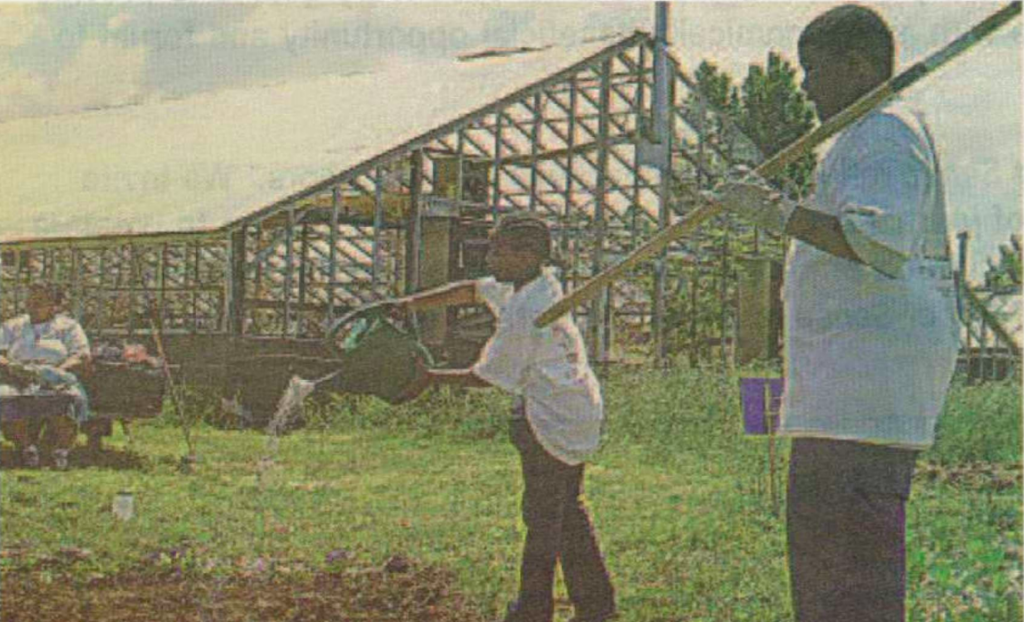It could not have been more aptly named. Situated in the crowded Anacostia neighborhood of Southeast D.C., a small nonprofit farm called Urban Oasis is just that: a sanctuary of peace, quiet, and vegetables in a city better known for its politics than its produce.
On a warm Saturday morning, dozens of volunteers from around the city can be found at work here at the one-acre farm. Tucked away in the corner of St. Elizabeth’s Hospital’s west campus, that enjoy fresh air, open space, and a beautiful view of the Anacostia River and downtown Washington. Adult and teenage volunteers dig up soil, plant flowers and vegetable, and push wheelbarrows full of mulch; younger children water the plants and then go to play.
The mission of Urban Oasis – a project of Community Harvest D.C. — is to provide the residents of Anacostia and other Ward 8 neighborhoods with healthy, affordable produce. The crops it grows supply local farmer’s markets, soup kitchens, and food pantries in the area, and its volunteer opportunities provide residents a chance to get outdoor exercise in a pleasant setting and to learn traditional and modern farming techniques. Volunteers also get a sense of business skills associated with trade and marketplace economies.
And Community Harvest hopes to expand its reach to someday provide chemical-free produce to all the 70,000 people living in Ward 8, the poorest of Washington’s eight wards and the only one without a full-service grocery store.
“Regardless of where people are living, they should have access to affordable and healthy food,” says Regina Dyson, Community Harvest’s executive director.
Urban Oasis is a part of the “urban agriculture” movement that aims to give inner-city communities access to locally grown, sustainable, healthy produce. And Dyson says that sustainable urban agriculture is the only way to ensure food security in areas such as Southeast D.C. She envisions a series of mini-farms—the size of Urban Oasis or smaller__ that would yield enough chemical-free produce to feed the entire community. Food would be grown locally and sold directly to customers at area farmer’s markets, which would keep prices down and keep consumer dollars within the community.
Such a system could be viable here in Washington. According to Sam Augusta, the farm manager at Urban Oasis, a well-farmed acre of land can produce enough food to feed 100 people for an entire year. Feeding Ward 8’s 70,000 residents, therefore, therefore would require only 700 acres—a mere one square-mile of farmable land. In a 2002 report, the D.C. Office for Planning and Economic Development reported that there were more than 13,000 vacant lots and abandoned parcels of land in the District, totaling 2,886 acres.
Furthermore, urban farming supporters say growing food locally rather than importing it from California and the Mid-west cuts down on waste and improves local economies. Studies have shown that a full 25 percent of imported produce rots before reaching its destination and supporting local famers would create local jobs.
While the plan seems sound on paper, however, in reality there are serious obstacles to content with. Augusta, who tends the crops and directs volunteers at Urban Oasis, lends a practical perspective to the issue. Having learned his trade on the vase farmlands of Ohio and Oregon, August is acutely aware of how limited space is in an urban setting, and how narrow the margins really are.
“Space here is valuable,” he says. “I look at the farm and see too many paths [the unfarmed space between beds]. We need to be more efficient.”
In addition, achieving sustainability will require more diverse crop production. “Right now, we’re growing to feed people from June through October. If we wanted to feed people for the rest of the year, we’d need to be growing potatoes, onion, corn, winter squash—storage crops,” says Augusta.
He also things a greenhouse and better security are key to securing good crops year-round.
Though obstacles to sustainability do exist, they are by no means insurmountable. Dyson insists that with time and effort, efficient urban agriculture can become a reality, and while she acknowledges the difficulty of transforming an entire economy, she points out that Washington is not the first major American city to try this. In fact, Dyson claims, “D.C. is far behind everyone else in the nation regarding the installment of a sustainable urban agricultural system.”
Indeed, successful programs are running across the country, most notably in Chicago, Detroit, New York, Philadelphia, and Seattle. These programs enjoy political support from the state, various degrees of private funding, large community involvement, and affiliations with local universities. Many large international metropolises, such as Hong Kong, have fully incorporated urban agriculture into their food economies, growing half of their vegetables within their city limits.
Washington, however, is far from reaching that kind of sustainability. In the meantime, Urban Oasis and other D.C.-based urban agriculture programs will do what they can. The bottom line, Dyson says, is that people have a right to eat well. “I don’t care if it’s grocery stores or farmer’s markets—I just want everyone to have access to healthy food.”
Furthermore, she says the benefits of these programs go beyond the tangible goods produced. Urban Oasis alone brings over 1,300 volunteers to assist in the planting, tending, and harvesting of crops every year, including many groups from local schools. In addition, Community Harvest provides youth outreach and learning programs that teach food security and environmental science.
Augusta, however, thinks the real draw is the chance to get earthy in a city covered with streets. “The volunteers, they just want to be outside,” he says, looking around the farm at young volunteers digging garden beds in the sun. “A lot of them are happy just to be touching dirt.”








